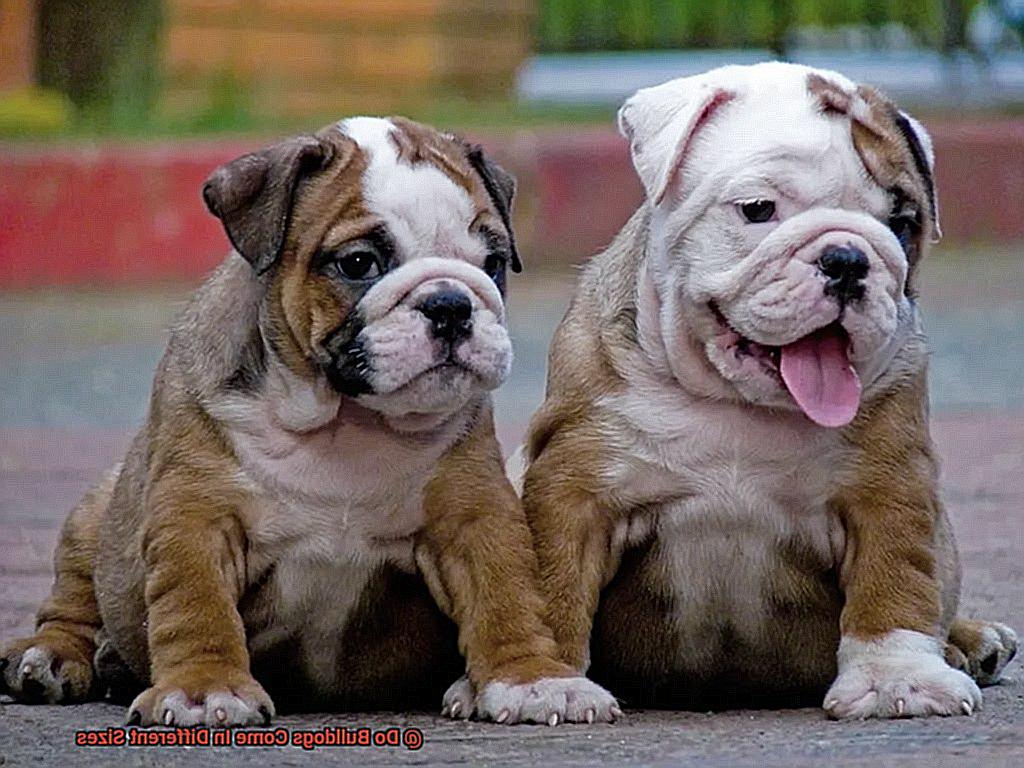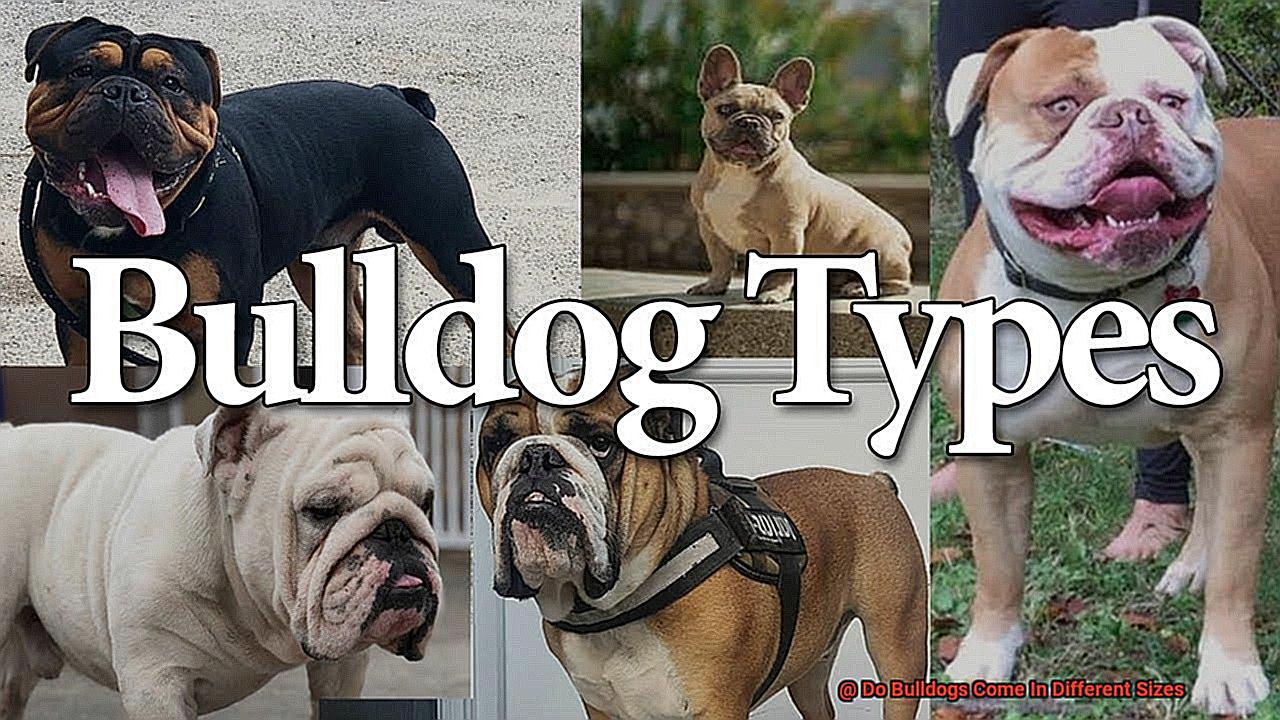Do Bulldogs Come In Different Sizes?
Welcome to today’s blog post all about Bulldogs and their size variations.
Bulldogs are such cool dogs, loved by so many for their unique looks and awesome personalities. You probably already know that Bulldogs have those wrinkly faces and chunky bodies that make them super cute.
But did you know that Bulldogs actually come in different sizes too? It’s true.
From the small and strong English Bulldogs to the slightly bigger French Bulldogs, there’s a Bulldog size for everyone. Whether you’re thinking about getting a Bulldog or just curious about their diversity, this article will explore all the different sizes of Bulldogs, what makes each one special, and why they’re so darn lovable.
So get ready to dive into the world of Bulldogs and discover why size really does matter when it comes to these awesome dogs.
The Breed Standard for Bulldogs
Contents
- 1 The Breed Standard for Bulldogs
- 2 Variations in Size Within the Breed
- 3 Factors That Influence Bulldog Size
- 4 Health and Quality of a Bulldog
- 5 Specialized Breeding Practices for Miniature and Giant Bulldogs
- 6 French Bulldogs vs English Bulldogs
- 7 Choosing the Right-Sized Bulldog for Your Needs
- 8 Consulting a Veterinarian or Breeder for Further Insights
- 9 Conclusion
If you’re a proud French Bulldog owner, you may have wondered about the different sizes Bulldogs come in. Bulldogs are known for their distinctive appearance and lovable personalities. In this article, we’ll dive into the breed standard for Bulldogs, including their sizes, to help you better understand your furry friend.
Understanding the Breed Standard:
The breed standard for Bulldogs is a set of guidelines and criteria that describe the ideal physical characteristics and temperament of the breed. These standards are established by kennel clubs and breed organizations to maintain the integrity and quality of Bulldogs.
Size Matters:
Bulldogs are generally considered medium-sized dogs, but there can be some variation in size within this category. The height at the shoulder for males typically ranges from 14 to 15 inches (35.5 to 38 cm), while females range from 13 to 14 inches (33 to 35.5 cm). Weight is also an important factor in determining size, with males weighing between 50 to 55 pounds (22.7 to 25 kg) and females weighing 40 to 50 pounds (18.1 to 22.7 kg).
Variations within the Breed:
While the breed standard provides general guidelines for Bulldog size, it’s important to note that there can be some variation due to factors such as genetics, breeding practices, and individual differences within the breed. However, extreme variations from the standard are not desirable.
Miniature and Giant Bulldogs:
Some breeders specialize in breeding Bulldogs that fall outside of the standard size range. These Bulldogs may be referred to as “miniature” or “giant” Bulldogs. However, it’s crucial to ensure that these breeders are reputable and prioritize the health and well-being of their dogs.
French Bulldogs: A Smaller Alternative:
If you’re specifically interested in a smaller Bulldog breed, French Bulldogs may be the perfect fit for you. French Bulldogs are smaller than their English counterparts, typically weighing between 16-28 pounds (7.2-12.7 kg). Their compact size makes them well-suited for apartments or homes with limited space.
Choosing the Right Size Bulldog:
When considering the size of a Bulldog, it’s important to take into account your own lifestyle and living situation. Smaller Bulldogs may be more suitable for those living in smaller spaces, while larger Bulldogs may require more room to move around.
Variations in Size Within the Breed

You’ve fallen in love with the adorable and charismatic French Bulldog. With their bat-like ears and compact size, they are undeniably one of the most popular breeds out there. But did you know that French Bulldogs, just like their Bulldog cousins, can come in different sizes within the breed? In this article, we’ll explore the variations in size within the Bulldog breed and help you understand how to choose the right size for your lifestyle.
Understanding the Different Sizes
The American Kennel Club (AKC) recognizes two different sizes for Bulldogs: standard and mini. Standard Bulldogs typically weigh between 40-50 pounds and stand around 14-15 inches tall at the shoulder. Mini Bulldogs, on the other hand, are smaller in size, weighing around 20-25 pounds and standing at about 10-12 inches tall.
However, it’s important to note that within each size category, there can still be a range of sizes. Factors such as genetics, diet, exercise, and overall health can influence the size of an individual Bulldog. So don’t be surprised if you come across Bulldogs that fall slightly outside of these measurements.
Breeders and Size Preferences
Breeders play a significant role in shaping the size variations within the breed. Some breeders may specialize in producing Bulldogs on the larger end of the spectrum for those who prefer a more substantial size. These larger Bulldogs may have more muscle mass and a robust stature.
On the other hand, some breeders may focus on producing Bulldogs on the smaller end of the spectrum for those who prefer a more compact size. These smaller Bulldogs may have a lighter frame and a daintier appearance.
Finding Your Perfect Fit
When searching for a French Bulldog puppy, it’s essential to communicate your desired size preferences with reputable breeders. They can help guide you in finding a puppy that matches your expectations. However, keep in mind that responsible breeders prioritize the health and temperament of the dog over achieving a specific size.
Consider Your Lifestyle
While it’s easy to get caught up in the cuteness of a tiny French Bulldog or the strength of a larger one, it’s crucial to consider your lifestyle when deciding on a preferred size. Larger Bulldogs may require more physical space and exercise, making them better suited for families with larger homes or access to outdoor areas. Smaller Bulldogs, on the other hand, may be more suitable for apartment living.
The Bottom Line
Variations in size within the Bulldog breed are normal and influenced by genetics, breeding practices, and individual factors. French Bulldogs, just like their Bulldog relatives, can come in different sizes, allowing potential owners to choose a size that suits their preferences and lifestyle.
Factors That Influence Bulldog Size
French Bulldogs are a popular breed known for their adorable appearance and charming personalities. If you’re considering bringing one into your home, it’s essential to understand the factors that can influence their size. While French Bulldogs generally fall within a specific size range, there can be some variations. Let’s take a closer look at the main factors that can affect the size of French Bulldogs.
- Genetics: Just like with any other dog breed, genetics play a significant role in determining the size of French Bulldogs. The genes passed down from their parents can influence their growth potential. If both parents are small in size, it’s more likely that the puppies will also be smaller. Conversely, if the parents are larger, the puppies may lean towards the bigger end of the scale.
- Breed Standards: French Bulldogs have specific breed standards that outline their ideal size and proportions. These standards are set by kennel clubs and breed associations to ensure consistency within the breed. According to the American Kennel Club (AKC), French Bulldogs should ideally weigh between 16-28 pounds and stand about 11-12 inches tall at the shoulder. Breeders strive to produce puppies that meet these standards.
- Nutrition: Providing your French Bulldog with a balanced and nutritious diet is crucial for their growth and development. Feeding them high-quality dog food in appropriate amounts helps support their optimal size. However, be mindful of overfeeding, as excess weight can lead to health issues and impact their overall size.
- Exercise: Regular exercise is essential for maintaining a healthy weight and muscle tone in French Bulldogs. Engaging in physical activities helps burn calories and prevents excessive weight gain. Make sure to provide them with daily walks, playtime, and mental stimulation to keep them physically fit.
- Health Issues: Some health conditions can affect the growth potential and size of French Bulldogs. For instance, certain congenital abnormalities or hormonal imbalances can lead to stunted growth. It’s vital to address any health concerns promptly and work closely with a veterinarian to ensure your French Bulldog’s optimal growth and development.
Health and Quality of a Bulldog
In this blog post, we will explore the significance of maintaining a healthy weight, providing proper grooming and hygiene, engaging in interactive playtime, and responsible breeding. Let’s dive in.
Maintaining a Healthy Weight:
French Bulldogs are prone to obesity, which can lead to various health issues. To keep your Frenchie fit and healthy, monitor their diet and ensure they receive the right amount of exercise. Consult with your veterinarian to determine the appropriate portion sizes and choose high-quality, balanced dog food. Regular exercise, such as short walks or play sessions, will help them maintain a healthy weight and prevent joint problems, heart disease, and breathing difficulties.
Proper Grooming and Hygiene:
French Bulldogs have a short coat that requires regular grooming to prevent skin infections and other dermatological problems. Brush their coat weekly to remove loose hair and dirt. Pay special attention to their facial wrinkles and clean them gently with a damp cloth to prevent bacterial growth. Regularly check their ears for signs of infection and clean them using a veterinarian-recommended solution. Trim their nails regularly to avoid discomfort or injury.
Engaging in Interactive Playtime:
French Bulldogs thrive on human companionship and mental stimulation. Engage in interactive play sessions to keep them mentally stimulated and physically active. Toys that encourage problem-solving skills, such as puzzle toys or treat-dispensing toys, can provide hours of entertainment. Remember, Frenchies may not be as energetic as some other breeds, so tailor the activities to their individual needs.
Responsible Breeding for Health and Quality:
When considering breeding your French Bulldog, it is essential to prioritize responsible breeding practices. Work with reputable breeders who prioritize genetic testing to eliminate potential health issues within their breeding lines. This helps reduce the likelihood of passing on genetic diseases and ensures that future generations of French Bulldogs are healthier.
Conclusion:
By maintaining a healthy weight, providing proper grooming and hygiene, engaging in interactive playtime, and promoting responsible breeding, you can ensure the health and quality of your French Bulldog. Remember, regular veterinary check-ups are crucial for early detection of any potential health issues. With your love and care, your Frenchie will lead a happy and fulfilling life for years to come.
Specialized Breeding Practices for Miniature and Giant Bulldogs
Today, we’re going to dive into the fascinating world of specialized breeding practices for miniature and giant Bulldogs. As an expert in this field, I’m excited to share my knowledge with you and shed light on how these unique bulldog breeds are created.
Miniature Bulldogs:
Miniature Bulldogs are adorable little versions of their standard-sized counterparts. They are created through selective breeding practices that aim to produce smaller-sized Bulldogs. So, how do breeders achieve this?
- Crossbreeding with smaller dog breeds: One way breeders create miniature Bulldogs is by introducing genes from smaller breeds like Pugs or French Bulldogs. This helps reduce the size of the offspring. However, it’s important to note that crossbreeding can result in variations in temperament and appearance compared to purebred Bulldogs.
- Selective breeding within the Bulldog breed: Another method used is selective breeding within the Bulldog breed itself. Breeders carefully select Bulldogs that are naturally smaller in size and mate them together to consistently produce miniature offspring. This requires expertise and knowledge of genetics to ensure the desired traits are passed down while maintaining the overall health and well-being of the dogs.
Giant Bulldogs:
If you’re someone who loves big dogs, then giant Bulldogs might be right up your alley. These gentle giants are bred to be larger than the standard size. Here’s how it’s done:
Selecting parent dogs with larger body frames: Breeders choose parent Bulldogs with larger body frames and selectively breed them together to produce larger offspring. By selecting parents known for producing larger puppies, breeders can increase the chances of creating giant Bulldogs.
It is important to note that both miniature and giant Bulldogs may not meet the breed standards set by kennel clubs or breed organizations. These unique sizes often result in variations that may not be recognized or accepted by official standards. However, there is still a demand for these alternative sizes among certain dog lovers who appreciate their distinctive characteristics.
In conclusion, specialized breeding practices are used to create miniature and giant Bulldogs. Breeders carefully select parent dogs with desired traits and mate them together to achieve the desired size. Whether you prefer a pint-sized companion or a larger-than-life cuddle buddy, these specialized bulldog breeds are sure to steal your heart. Remember, regardless of their size, it’s crucial for breeders to prioritize the health and well-being of these amazing dogs throughout the breeding process.
French Bulldogs vs English Bulldogs
When it comes to French Bulldogs and English Bulldogs, there’s more than meets the eye. These two breeds may look similar, but they have distinct differences that every bulldog enthusiast should know. Let’s dig in and explore the disparities in size and origin between these beloved breeds.
Size Matters: French Bulldogs vs English Bulldogs
French Bulldogs may be small, but they bring a whole lot of personality to the table. Standing at around 11 to 12 inches tall and weighing between 16 to 28 pounds, these pint-sized pooches are perfect for those who prefer a compact canine companion. On the other hand, English Bulldogs are larger in size, measuring about 14 to 15 inches tall and tipping the scales at a hefty 40 to 50 pounds. So, if you’re looking for a dog that’s easy to carry around or fits snugly on your lap, the French Bulldog might be your best bet.
Origins: Tracing Their Bulldoggy Roots
The origins of these bulldog breeds shed light on their disparate sizes. French Bulldogs were first bred in France (no surprise there) as a smaller version of their English cousins. Developed for companionship rather than bull-baiting (a gruesome sport involving dogs and bulls), Frenchies were selectively bred for a more compact size, making them ideal for apartment living or cozy homes.
Meanwhile, English Bulldogs have a longer history and hail from England (bet you didn’t see that coming.). Initially bred for bull-baiting (yes, we mentioned it again), these muscular bulldogs needed to be larger and stronger to take down those mighty bulls. Although bull-baiting is now history, the English Bulldog’s size stuck around like an old friend.

Appearance: Wrinkles and Snorts Galore
When it comes to facial features, both French Bulldogs and English Bulldogs are masters of cuteness. They both sport those adorable pushed-in noses, wrinkled foreheads, and droopy jowls that make any heart melt.
However, the differences lie in their body structures. French Bulldogs have a sleek and streamlined silhouette, while English Bulldogs have a more robust and muscular build. Think of it this way: Frenchies are like the compact sports car of the bulldog world, while English Bulldogs are the big, sturdy SUVs.
Choosing the Right-Sized Bulldog for Your Needs
Are you considering getting a French bulldog? These adorable little dogs are known for their unique appearance and friendly personalities. But before you bring one home, it’s important to choose the right-sized bulldog for your needs. Here are some expert tips to help you make the best decision.
Consider Your Living Situation
French bulldogs are a great choice for apartment living because of their small size. They don’t require a lot of space to run around, making them ideal for those with limited living quarters. On the other hand, if you have a larger home or a big yard, you may have more flexibility when it comes to choosing the size of your bulldog.
Think About Your Lifestyle
Are you an active person who loves to go on long walks or hikes? Or do you prefer to spend your evenings snuggled up on the couch? French bulldogs, in general, are not highly active dogs, but there can still be variations in energy levels among different sizes. If you’re looking for a more laid-back companion, a smaller bulldog may be a better fit.
Consider Your Physical Capabilities
Bulldogs, even in their smaller sizes, can be quite strong and sturdy. If you have any physical limitations or concerns about handling a larger dog, it may be wise to opt for a smaller bulldog. This will make it easier for you to manage and control your furry friend during walks or other activities.
Be Aware of Potential Health Risks
Different sizes of bulldogs can have different health risks. Larger bulldogs may be more prone to joint problems and obesity-related issues, while smaller bulldogs may be more susceptible to breathing difficulties and other respiratory issues. It’s important to be aware of these potential health risks and consult with a veterinarian when making your decision.
Do Your Research on Reputable Breeders
There is no standard size classification for bulldogs, and different breeders may have variations in their breeding programs. It’s important to do thorough research on reputable breeders who prioritize the health and well-being of their dogs. This will help ensure that you bring home a healthy and well-adjusted bulldog.
Consulting a Veterinarian or Breeder for Further Insights
When it comes to understanding the potential size range of your French bulldog, consulting a veterinarian or breeder can provide invaluable insights. These professionals have the knowledge and experience to help you better understand the size variations within the breed and what factors may influence your bulldog’s size.
Here are some reasons why consulting a veterinarian or breeder can be beneficial:
- Expert Advice: Veterinarians are medical professionals who specialize in animal health. They can provide expert advice on various aspects of bulldog care, including size variations. Breeders, on the other hand, have firsthand experience with different sizes within the bulldog breed. Their knowledge can help you make informed decisions about your pet’s size.
- Specific Questions: When consulting a veterinarian or breeder, it’s important to ask specific questions related to bulldog sizes. For example, you can ask whether there are different size variations within the breed and what factors may influence your bulldog’s size. By asking these questions, you can gain a better understanding of what to expect.
- Health Considerations: Veterinarians may also be able to provide information on any known health issues that are associated with specific size variations in bulldogs. This can help you prepare for any potential health risks that may arise based on your bulldog’s size.
- Reputable Sources: It’s crucial to choose a reputable veterinarian or breeder who has a good understanding of bulldogs. They should be able to provide accurate information based on their expertise and experience. Researching and choosing the right professional will ensure that you are receiving reliable information.
- Nutrition and Exercise Guidance: In addition to providing insights on size variations, veterinarians and breeders can offer guidance on proper nutrition and exercise routines for your bulldog. This can help maintain a healthy weight and size for your pet, ensuring their overall well-being.
GP6HQ1JUxa8″ >
Conclusion
In conclusion, it is clear that Bulldogs do come in different sizes.
From the compact and muscular Miniature Bulldog to the larger and more imposing English Bulldog, there is a range of sizes within this beloved breed. Whether you prefer a pint-sized companion or a robust and sturdy companion, Bulldogs offer options for every dog lover.
So, if you’re considering adding a Bulldog to your family, remember to consider the size that best suits your lifestyle and preferences.




